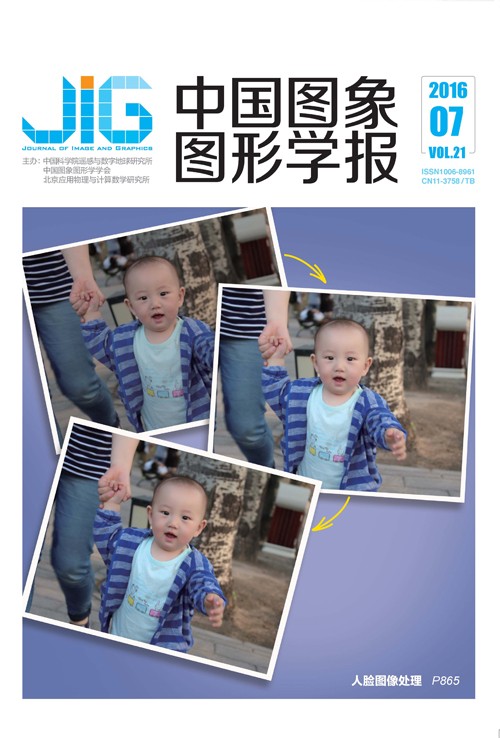
结合全局与局部信息活动轮廓的非同质图像分割
摘 要
目的 通过对现有基于区域的活动轮廓模型能量泛函的Euler-Lagrange方程进行变形,建立其与K-means方法的等价关系,提出一种新的基于K-means活动轮廓模型,该模型能有效分割灰度非同质图像。方法 结合图像全局和局部信息,根据交互熵的特性,提出新的局部自适应权重,它根据像素点所在邻域的局部统计信息自适应地确定各个像素点的分割阈值,排除灰度非同质分割目标的影响。结果 采用Jaccard相似系数-JS(Jaccard similarity)和Dice相似系数-DSC(Dice similarity coefficient)两个指标对自然以及合成图像的分割结果进行定量分析,与传统及最新经典的活动轮廓模型相比,新模型JS和DSC的值最接近1,且迭代次数不多于50次。提出的模型具有较高的计算效率和准确率。结论 通过大量实验发现,新模型结合图像全局和局部信息,利用交互熵特性得到自适应权重,对初始曲线位置具有稳定性,且对灰度非同质图像具有较好地分割效果。本文算法主要适用于分割含有噪声及灰度非同质的医学图像,而且分割结果对初始轮廓具有鲁棒性。
关键词
Inhomogeneous image segmentation based on active contours with global and local information
Hao Zhihui, Guo Mancai, Song Yangyang(School of Sciences, Northwest A&F University, Yangling 712100, China) Abstract
Objective Active contour models (ACMs) are efficient frameworks for image segmentation. They can provide smooth and closed contours to recover object boundaries with sub-pixel accuracy. Region-based ACMs identify each region of interest by using region and statistical information as constraints to guide the motion of the active contour. The most popular region-based ACM is the Chan-Vese (C-V) model, which has been successfully used in binary phase segmentation with the assumption that image intensities are homogeneous in each region. However, typical region-based models do not work well on images with intensity inhomogeneity. This paper presents a new level-set-based K-means ACM, which can effectively segment images with intensity inhomogeneity. The model is derived from a linear level-set-based K-means model, which is established based on the properties of the corresponding Euler-Lagrange equation of the traditional ACM. Method The most widely used region-based ACMs are used, namely, the global region-based ACM, C-V model; the local region-based ACM, the local binary fitting (LBF) model; the local image fitting (LIF) model; and the local correntropy-based K-means (LCK) model. Their fitting terms correspond to the classical K-means. The C-V model has a global segmentation capacity, that is, it can segment all objects in an image; however, it cannot handle images with intensity inhomogeneity and various noises. The LBF and LIF models possess a local segmentation property; thus, they can only segment the desired object with a proper initial contour. In this paper, we propose a new region-based ACM, which integrates the advantages of global and local region-based ACMs. The global information and local information are combined to avoid entrapment in the local minima, and the local correntropy-based adaptive weights are used to ensure robustness against noise and fast convergence. Result The proposed model can successfully detect objects in a noisy synthetic image with intensity inhomogeneity. Results of the experiments on medical images show that compared with the background models, the proposed model can yield competitive results. Furthermore, when different initial contours are used, the proposed model can still realize correct segmentation for inhomogeneous images, whereas the other models are easily trapped in the local minima. This segmentation results demonstrate that the proposed model is not only capable of obtaining better segmentation results but also robust against noise and initializations. Conclusion A novel and robust ACM based on K-means is proposed to segment images with intensity inhomogeneity. Relying on the correntropy-based image features, the model uses local adaptive weights to withstand various noises. Moreover, the combination of local and global region information prevents the proposed model from being trapped into a local minimum. To avoid re-initialization and shorten the computational time, we use a signed distance function to regularize the level set function and adopt an iteratively re-weighted method to enhance the speed of our algorithm during the contour evolution. The experimental results show that our algorithm can achieve robust segmentation even in the presence of the intensity inhomogeneity, noise, and blur.
Keywords
|



 中国图象图形学报 │ 京ICP备05080539号-4 │ 本系统由
中国图象图形学报 │ 京ICP备05080539号-4 │ 本系统由